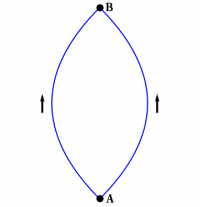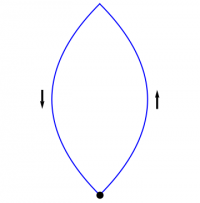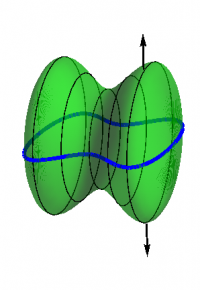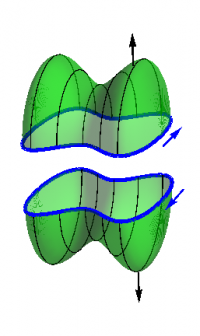Second derivatives
A conservative vector field is the gradient of some function, for example \begin{eqnarray*} \EE = - \grad V \end{eqnarray*}
But integrals of conservative vector fields are independent of path, so that evaluating the integral along two different paths between the same two points yields the same answer, as illustrated in Figure 1. Combining two such paths into a closed loop changes the orientation of one path, as shown in Figure 2, and the integrals now cancel; the integral of $\grad V$ around any closed loop vanishes. Using Stokes' Theorem, we therefore obtain \begin{equation} \Int_{\rm inside} \!\! (\grad\times\grad V) \cdot d\AA = \oint\limits_{\rm loop} \grad V \cdot d\rr = 0 \qquad\quad \label{curlgrad} \end{equation} Equivalently, the Master Formula tells us how to evaluate the left-hand side of (\ref{curlgrad}), namely by evaluating the potential at the endpoints. Since both endpoints are the same, the integral must be zero. But since the left-hand side must vanish for any closed curve, the integrand must be identically zero. We have proved that \begin{eqnarray*} \grad\times\grad V = \zero \end{eqnarray*} for any function $V$.
A similar argument can be used to show that \begin{eqnarray*} \grad\cdot(\grad\times\FF) = 0 \end{eqnarray*} for any vector field $\FF$. Consider a closed surface. Cut it in half along some closed curve, as shown in Figure 3a. Then each piece of the surface is a butterfly net with the same rim, as shown in Figure 3b (with the pieces separated for clarity). Applying Stokes' Theorem to each piece leads to the conclusion that the flux of the curl of $\FF$ upward through each piece must be the same, so that the flux up through the top cancels the flux downward through the bottom. This cancellation forces the flux of the curl of $\FF$ outward through the entire surface to vanish. Using the Divergence Theorem, we get \begin{eqnarray*} \Int_{\rm inside} \grad\cdot(\grad\times\FF) \, d\tau = \Int_{\rm surface} (\grad\times\FF)\cdot d\AA = 0 \end{eqnarray*} This argument shows that the first integral is zero over any volume, forcing the integrand to vanish, as claimed.
The above identities can also be derived by direct computation, most easily done in rectangular coordinates. For instance, when calculating the curl of $\grad{V}$, each component will contain mixed second-order partial derivatives of $V$, for example: \begin{eqnarray*} \grad\times\grad V = … + \left( \Partial{}{x}\Partial{V}{y} - \Partial{}{y}\Partial{V}{x} \right) \,\kk \end{eqnarray*} But partial derivatives can be taken in any order, so the derivatives above cancel, thus proving the identity. Similar second-order derivatives arise when computing the divergence of $\grad\times\AA$, establishing the other identity.



